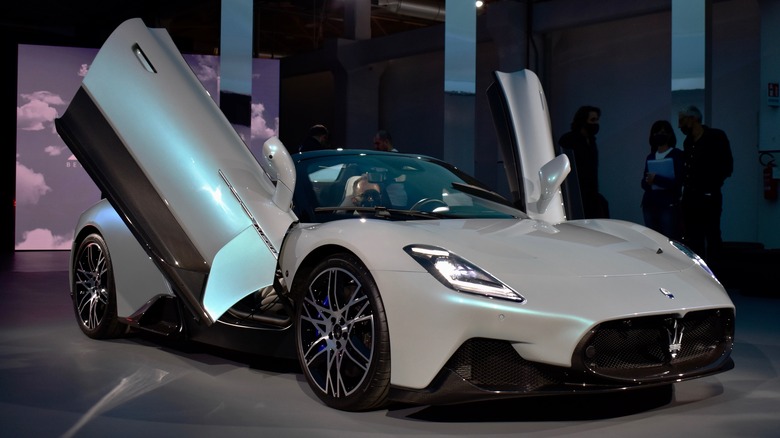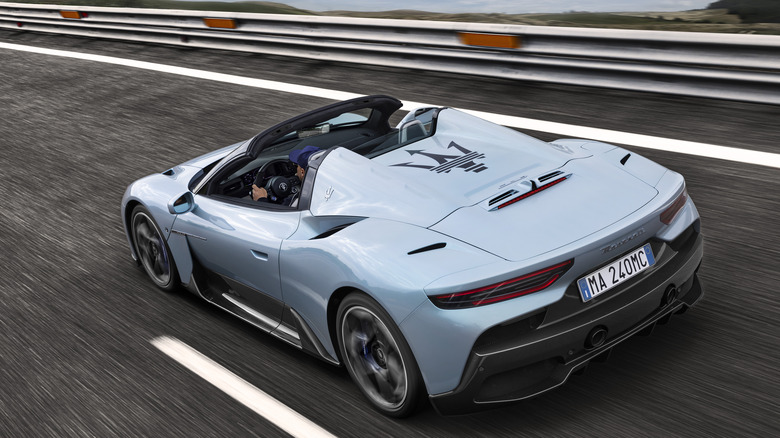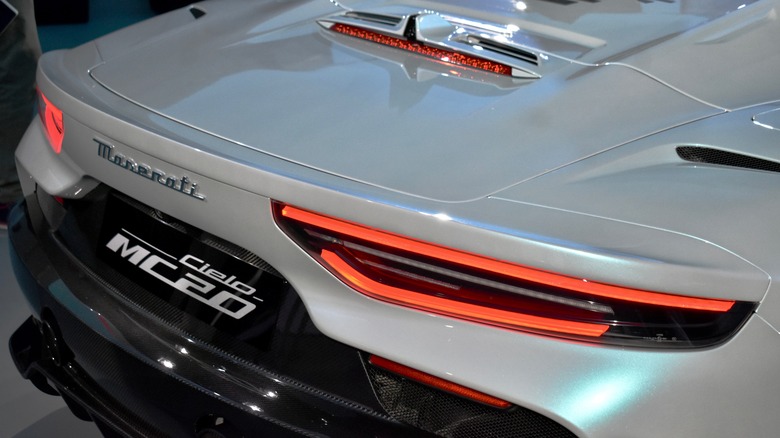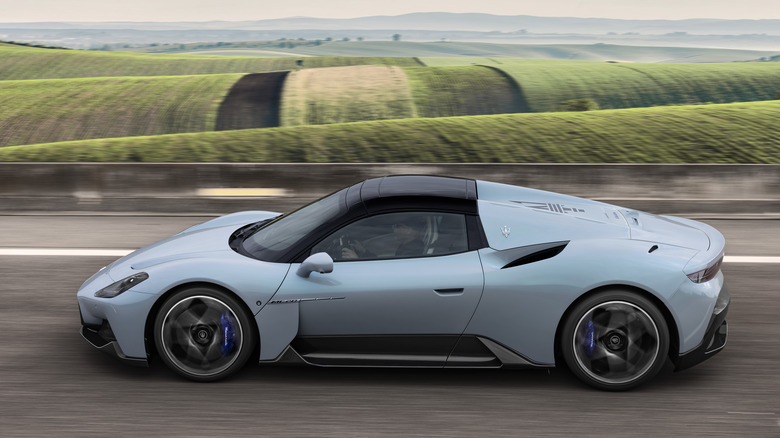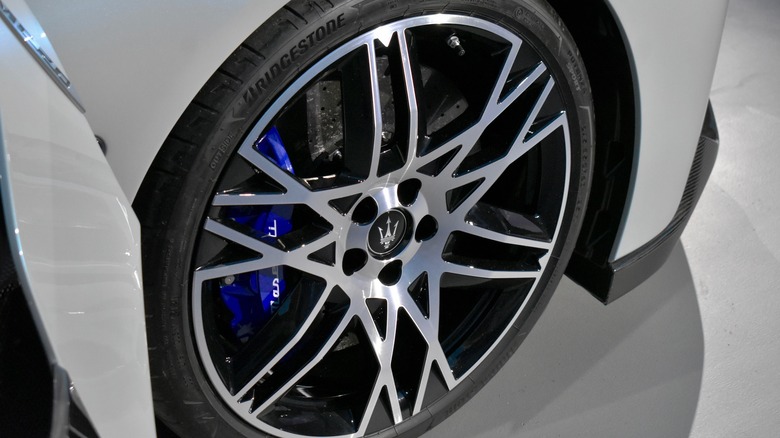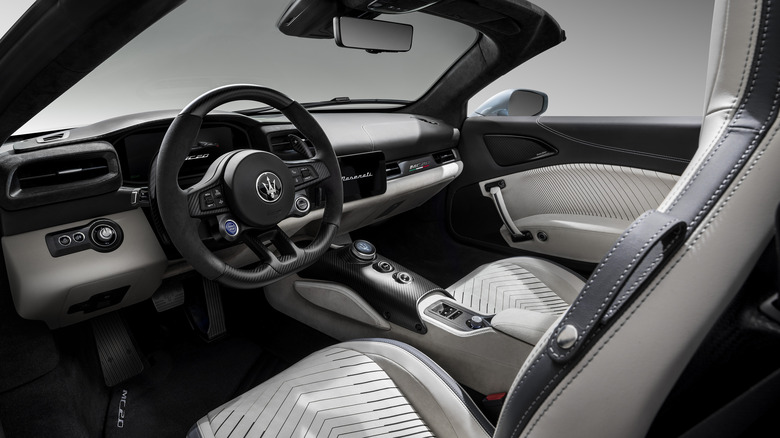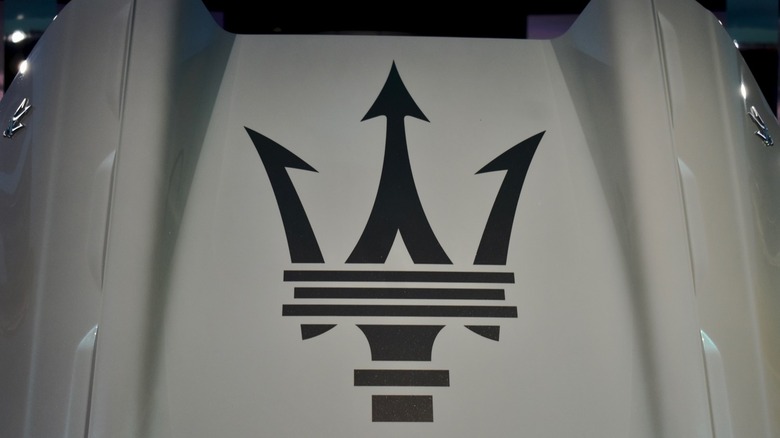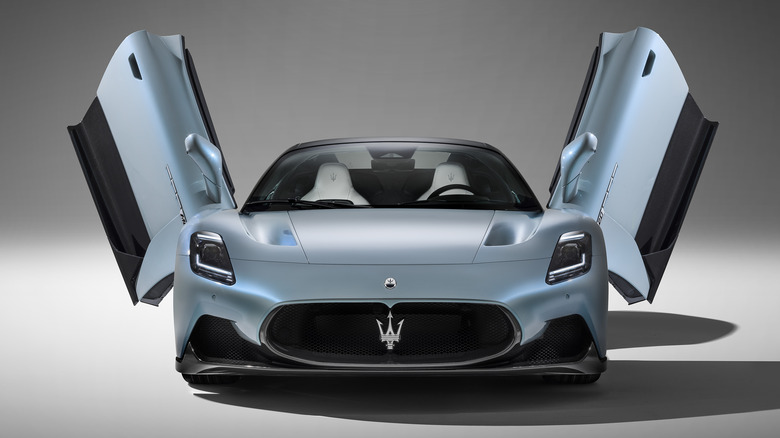2023 Maserati MC20 Cielo Revealed As Sun-Loving Convertible Supercar: First Look
A convertible version of the Maserati MC20 was as inevitable as the next Marvel movie. Convertible supercars have always been popular among the extroverted wealthy, and Maserati has been without a droptop since the GranTurismo convertible was discontinued in 2019.
So, roughly a year and a half after the MC20 coupe's unveiling, we have the 2023 Maserati MC20 Cielo. While Maserati has traditionally applied the Spyder name to its convertibles, this time it went with Cielo, the Italian word for sky. An appropriate moniker for a convertible, admittedly, particularly one whose butterfly doors reach up to the sky whenever you open them.
Nothing but blue skies
The Cielo has a retractable electrochromic glass roof with polymer-dispersed liquid crystal (PDLC) technology that makes it possible to change the transparency instantly, according to Maserati.
This isn't an entirely new idea; Ferrari introduced the Revocromico electrochromic roof on the 575M-based Superamerica in 2004. That was a targa roof rather than a full convertible, however, and while the McLaren 720S also offers an electrochromic roof and a full convertible top, it can't go full opaque. So you're still likely to get a sunburned head, Federico Landini, head of the MC20 line, quipped during a pre-unveiling media briefing.
The roof can open or close in just 12 seconds and at vehicle speeds of up to 31 mph, and Maserati says it doesn't impact cargo space when stowed. It sits under a Cielo-specific polycarbonate engine cover — replacing the clear cover from the MC20 coupe — and which, if you really want people to know what you're driving, can be emblazoned with a giant Maserati Trident decal.
The same, but different
Convertible conversions sometimes ruin existing designs. Maserati design boss Klaus Busse said making the Cielo look right involved matching the coupe's roofline and hiding the mass of the convertible top mechanism.
Both tasks were accomplished by the fairings behind the seats, which were necessary for crashworthiness anyway, Busse said. They follow the original coupe roofline, and also disguise the added height required for the convertible top mechanism. The only downside is that, because the folded roof sits on top of the engine, you don't actually get to see the mechanical artwork underneath.
Maserati claims the retractable roof doesn't lessen aerodynamic efficiency, but its engineers and designers did make some changes to accommodate it. Because the Cielo couldn't use the MC20 coupe's vented engine cover, air intakes were repositioned, new outlets were added to extract hot air from the engine compartment, and new rear air intakes help direct air to the intercoolers.
Give and take
Even with the best engineering involved, going topless inevitably brings some compromises too. A retractable roof inherently reduces torsional rigidity, for example, but Maserati's engineers were prepared to deal with that from the start.
The automaker actually engineered distinct versions of the MC20's carbon fiber monocoque chassis for the coupe and Cielo versions, as well as a forthcoming all-electric version of the car, back when it first began the supercar project. That way, it wouldn't be left playing catch-up as new variants were announced. In the case of the Cielo specifically, differences in the distribution of carbon fiber used for the chassis help get some of that rigidity back.
The layup — the way the carbon fiber sheets are arranged on the monocoque form — is different in the convertible, and there are some new structural elements in the doors. The roof mounting also adds some torsional stiffness, Landini noted.
Same Nettuno engine
The Cielo gets the same, 3.0-liter twin-turbocharged Nettuno V6 as we experienced in the MC20 coupe, with an unchanged output of 621 horsepower and 538 pound-feet of torque. The mid-mounted engine sends that power to the rear wheels through an eight-speed dual-clutch transmission.
A V6 engine might not seem exotic enough for a supercar, but then this is no ordinary six-cylinder. As it waves goodbye to its Ferrari engine supply, Maserati developed the Nettuno in-house with some aggressive demands for performance and cutting-edge tech to deliver on them. It features pre-chamber combustion, for example, which adds a second spark plug and combustion chamber to each cylinder to get the process of burning fuel and air started before the mixture reaches the main chamber.
This is how Maserati was able to extract over 600 hp from a relatively small engine, while still keeping it civilized enough for everyday use. And, as Maserati is quick to point out, it's derived from Formula One racing engines for the appropriate blast of heritage.
Still seriously fast
The MC20 Cielo has a quoted curb weight of 3,395 pounds, or 144 pounds more than the coupe. That's not insignificant, but it doesn't seem to blunt performance all that much. Maserati claims the Cielo will do zero to 62 mph in approximately 3.0 seconds, compared to 2.9 seconds for the coupe. Top speed is 198 mph, while the coupe can allegedly reach 202 mph. All around, still mighty impressive numbers, not least considering the engine size.
Like the coupe, the MC20 Cielo also gets adjustable suspension and five drive modes: Wet, GT, Sport, Corsa, and finally ESC Off if you're feeling adventurous. It also features a front-axle lift system, to help avoid scraping that carbon-fiber nose on steep driveways.
Top-down tech
The Cielo's cabin tech features carry over from the MC20 coupe as well. The Maserati Intelligent Assistant (MIA) infotainment system includes a 10.25 digital instrument cluster and 10.25-inch touchscreen, with an Android Automotive-based operating system. That's a huge improvement over the Stellantis-sourced software that other models in the Maserati line-up are equipped with.
A 12-speaker Sonus Faber audio system is available as well. This is similar to the system in the MC20 coupe, but Maserati says that its dynamics were retuned so as to account for the acoustic changes depending on whether the roof is open or closed.
Maserati has tried to keep analog controls to a respectable minimum, and that process continues with the MC20 Cielo. You can lower the roof using the central touchscreen, and the convertible gets a new touchpad drive mode selector. The latter will make its way into the MC20 coupe for the 2023 model year as well.
Coming soon to a picturesque driving road near you
Deliveries of the new convertible are expected to start in late 2022 or early 2023. Maserati hasn't announced pricing, but said the Cielo will likely cost about $30,000 more than the MC20 coupe, itself a six-figure car. Given the hard-top starts at $212,000 (plus $3,995 destination), but can easily spiral up to $300k with options, the Cielo will definitely have the price tag of a supercar.
The first production cars will be PrimaSerie launch edition models, with a special Acquamarina exterior color and matte black 20-inch wheels. Inside, there'll be what Maserati describes as an ice-colored Alcantara and leather interior. Less than 100 will be built, in total, but Maserati hasn't decided on a specific number. Buyers should also be able to take advantage of the Fuoriserie Customization Program, the automaker's bespoke division.
Down the line, meanwhile, Maserati has at least one more MC20 variant planned. The all-electric MC20 Folgore will arrive sometime before 2025, part of the automaker's big zero-emissions roadmap, replacing the Nettuno V6 with a new EV drivetrain. Specifications for that haven't been shared yet, but the Folgore will have the Cielo's folding hardtop, MC20 line boss Landini said. So, Maserati's first electric sports car will also be a convertible.
